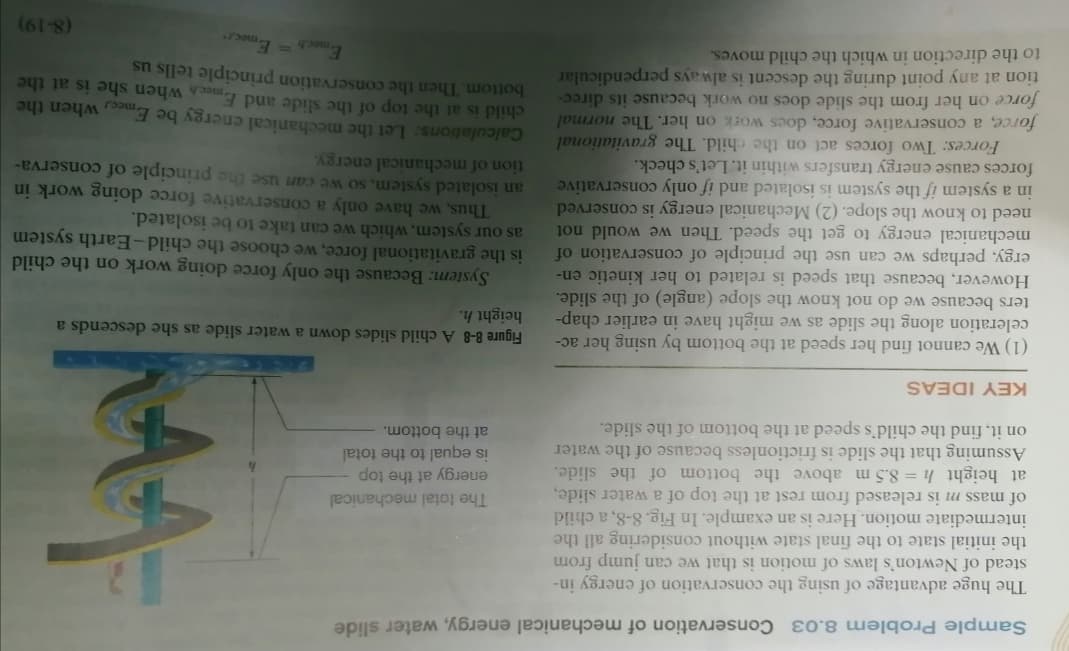In Sample Prob. 8.03, there are no non- conservative forces acting on the child as it slides down. At the highest points, the kinetic energy of the child is zero joules. At the lowest point as it slides, the potential energy is zero joules. Which one of the following describes the kinetic and potential energies of the child at the point in the middle between the highest and lowest points? a. K=0, U= U, %3D max b. K= U С. K>U K
In Sample Prob. 8.03, there are no non- conservative forces acting on the child as it slides down. At the highest points, the kinetic energy of the child is zero joules. At the lowest point as it slides, the potential energy is zero joules. Which one of the following describes the kinetic and potential energies of the child at the point in the middle between the highest and lowest points? a. K=0, U= U, %3D max b. K= U С. K>U K
University Physics Volume 1
18th Edition
ISBN:9781938168277
Author:William Moebs, Samuel J. Ling, Jeff Sanny
Publisher:William Moebs, Samuel J. Ling, Jeff Sanny
Chapter8: Potential Energy And Conservation Of Energy
Section: Chapter Questions
Problem 51P: (a) Sketch a graph of the potential energy function U(x)=kx2/2+Aex2 where k , A, and are constants....
Related questions
Topic Video
Question

Transcribed Image Text:Sample Problem 8.03 Conservation of mechanical energy, water slide
The huge advantage of using the conservation of energy in-
stead of Newton's laws of motion is that we can jump from
the initial state to the final state without considering all the
intermediate motion. Here is an example. In Fig. 8-8, a child
of mass m is released from rest at the top of a water slide,
at height h = 8.5 m above the bottom of the slide.
Assuming that the slide is frictionless because of the water
on it, find the child's speed at the bottom of the slide.
The total mechanical
energy at the top
is equal to the total
at the bottom.
KEY IDEAS
(1) We cannot find her speed at the bottom by using her ac-
celeration along the slide as we might have in earlier chap-
ters because we do not know the slope (angle) of the slide.
However, because that speed is related to her kinetic en-
ergy, perhaps we can use the principle of conservation of
mechanical energy to get the speed. Then we would not
need to know the slope. (2) Mechanical energy is conserved
in a system if the system is isolated and if only conservative
forces cause energy transfers within it. Let's check.
Forces: Two forces act on the child. The gravitational
force, a conservative force, does work on her. The normal
force on her from the slide does no work because its direc-
Figure 8-8 A child slides down a water slide as she descends a
height h.
System: Because the only force doing work on the child
is the gravitational force, we choose the child-Earth system
as our system, which we can take to be isolated.
Thus, we have only a conservative force doing work in
an isolated system, so we can use the principle of conserva-
tion of mechanical energy.
Calculations: Let the mechanical energy be Emees when the
child is at the top of the slide and Emech when she is at the
bottom. Then the conservation principle tells us
tion at any point during the descent is always perpendicular
Ech= Emecr
to the direction in which the child moves.
(8-19)

Transcribed Image Text:In Sample Prob. 8.03, there are no non-
conservative forces acting on the child as it
slides down. At the highest points, the
kinetic energy of the child is zero joules. At
the lowest point as it slides, the potential
energy is zero joules. Which one of the
following describes the kinetic and potential
energies of the child at the point in the
middle between the highest and lowest
points?
a. K=0, U=U
max
b.
K= U
С.
K>U
d.
K<U
U= 0, K= K
е.
ax
Expert Solution
This question has been solved!
Explore an expertly crafted, step-by-step solution for a thorough understanding of key concepts.
Step by step
Solved in 2 steps with 1 images

Knowledge Booster
Learn more about
Need a deep-dive on the concept behind this application? Look no further. Learn more about this topic, physics and related others by exploring similar questions and additional content below.Recommended textbooks for you

University Physics Volume 1
Physics
ISBN:
9781938168277
Author:
William Moebs, Samuel J. Ling, Jeff Sanny
Publisher:
OpenStax - Rice University

Physics for Scientists and Engineers: Foundations…
Physics
ISBN:
9781133939146
Author:
Katz, Debora M.
Publisher:
Cengage Learning

Principles of Physics: A Calculus-Based Text
Physics
ISBN:
9781133104261
Author:
Raymond A. Serway, John W. Jewett
Publisher:
Cengage Learning

University Physics Volume 1
Physics
ISBN:
9781938168277
Author:
William Moebs, Samuel J. Ling, Jeff Sanny
Publisher:
OpenStax - Rice University

Physics for Scientists and Engineers: Foundations…
Physics
ISBN:
9781133939146
Author:
Katz, Debora M.
Publisher:
Cengage Learning

Principles of Physics: A Calculus-Based Text
Physics
ISBN:
9781133104261
Author:
Raymond A. Serway, John W. Jewett
Publisher:
Cengage Learning

Classical Dynamics of Particles and Systems
Physics
ISBN:
9780534408961
Author:
Stephen T. Thornton, Jerry B. Marion
Publisher:
Cengage Learning